Choosing the Right Skate Shoes for Top Performance
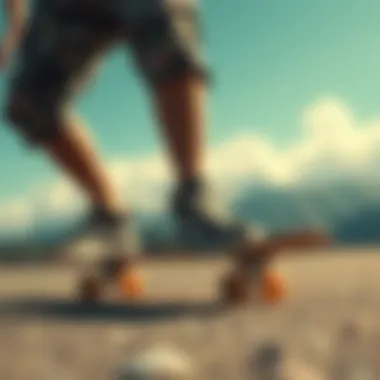
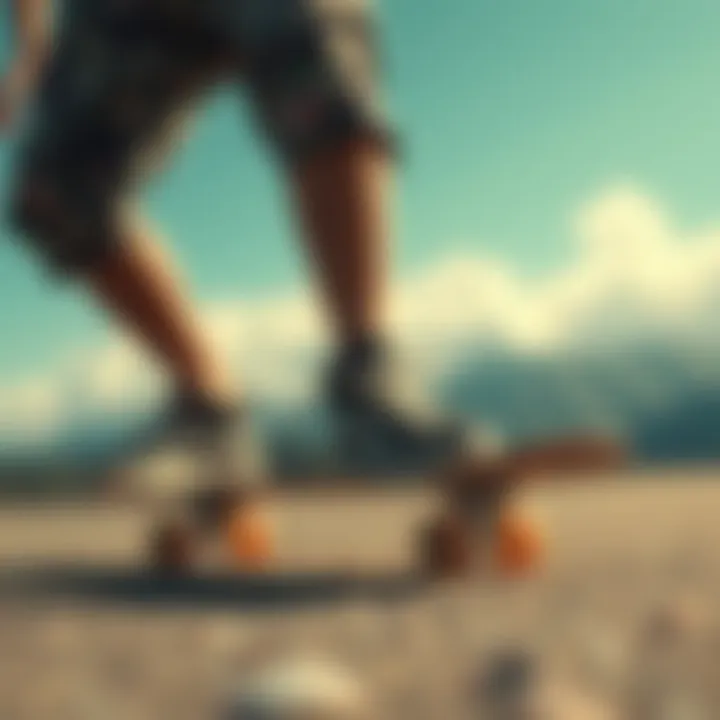
Intro
When it comes to skateboardig, your footwear plays a crucial role in not just how you ride, but also in ensuring your safety. Selecting the right skate shoes isn't just a trivial choice – it can mean the difference between smoothly landing a trick or taking a spill. Understanding what to look for in a skate shoe may seem a bit daunting, but it’s essential to dive into this subject.
In this article, we're going to break down every corner of skate shoe selection. We’ll discuss key features that enhance performance, such as grip, support, and comfort. The materials used and the overall design will also be in the spotlight, shedding light on how these elements contribute to your skateboarding experience. Let’s be real; no one wants to be fumbling around with ill-fitted shoes while trying to pull off sick tricks.
"The right pair of skate shoes can elevate your game, giving you more confidence on your board."
So, whether you are a newbie getting your feet wet or a seasoned skater looking for the next pair that could potentially refine your skills, the insights you gain from this discussion are going to serve you well. As we delve into the nitty-gritty of this process, you’ll become equipped with the knowledge to make informed decisions that align with your individual needs and style.
Understanding the Importance of Proper Skate Shoes
Skateboarding is as much about style as it is about technique, but at the core of any successful session is the footwear. Choosing the right skate shoes is crucial, not just for personal flair but for optimal performance and safety on the board. The importance of proper skate shoes extends beyond mere aesthetics; they serve as a vital connection between the rider and the board, impacting the overall experience and longevity of both the skater and the equipment.
Having suitable shoes ensures a blend of cushioning, grip, and support, helping in executing tricks while safeguarding against potential injuries. The right fit allows for better board control, which is necessary when conquering complex maneuvers. This article will uncover the fundamental elements of skate shoes and highlight why skaters—whether casual or professional—should invest time in selecting the ideal pair.
Impact on Performance and Safety
The relationship between skate shoes and performance can’t be overstated. Think of skate shoes as the unsung heroes; if they’re not up to par, the whole act can suffer. Proper footwear boosts performance through enhanced grip and board feel, allowing skaters to stick their tricks confidently. A shoe that lacks grip can lead to slips and falls, turning a simple flip into a damaging misadventure. Moreover, the cushioning in the sole absorbs some of the impact from landing, which can significantly reduce fatigue during long sessions.
Safety is another critical aspect affected by skate shoes. Well-designed shoes provide support to the ankle, reducing the risk of sprains or fractures caused by wobbling on uneven ground. Shoes infused with quality materials can also give sturdiness to withstand the wear-and-tear of skateboarding, adding an extra layer of defense against unpredictable terrain. As you can see, making a thoughtful choice in footwear not only elevates performance but importantly ensures that the risk of sustaining an injury is minimized.
Common Skateboarding Injuries
When discussing skateboarding, a few injuries come to mind right away—ankle sprains, fractures, and cuts to name a few. Most of these mishaps can often be traced back to inadequate footwear. For instance, a slip due to insufficient grip can result in a nasty spill, possibly affecting the wrist or shoulder upon landing. Similarly, an improper shoe can lead to a misstep during a trick, causing a twist in the ankle.
- Ankle Sprains: One of the most frequent injuries among skaters is the sprained ankle. Wearing shoes without ample support makes the ankle more susceptible to such injuries when landing poorly or pivoting suddenly.
- Fractured Bones: In unfortunate circumstances, a fall might lead to fractures, particularly in the wrist or arm. Shoes that fit well and provide adequate support can help to mitigate this risk.
- Cuts and Scrapes: More minor but common injuries, often caused by falls, can occur if the skateboard strikes the foot or if the skater lands on rough surfaces. Some skate shoes come with features designed to prevent such occurrences, proving their worth.
Investing in quality skate shoes is not just about style points; it’s a significant way to protect oneself and perform at the top of one’s game. The better the shoe, the more enjoyable and safer the skateboarding experience, leading to more time spent on the board and less time nursing injuries.
"Choosing a good skate shoe is like building the right foundation for a house; without it, everything else can crumble." - An old skater's cliche that holds quite a bit of truth.
Key Features to Consider in Skate Shoes
When it comes to skateboarding, shoes aren’t just accessories; they are pivotal to performance and safety. Every skater from novice to pro must understand what features to look for in skate shoes to ensure optimal performance. The connection between a skater and their board is deeply impacted by the footwear chosen.
Selecting the right pair means more than just aesthetics—it’s about how the shoes can enhance riding experience, provide protection, and withstand the rigors of the sport. The proper shoes offer improved grip, adequate support, and durability. Here, we will dissect these important features to grant you insights that lead to better choices on your skate journey.
Grip and Traction
The rubber sole of skate shoes plays a significant role in how well you stick to the board. Grip refers to the ability of the shoe to maintain contact with the surface of the skateboard deck, preventing slips or unwanted slide-offs. Many brands, including Vans and Nike SB, employ special rubber compounds to increase friction on the board, enhancing maneuverability.
When considering grip, the tread pattern on the shoe’s sole is crucial. A flat, less contoured sole allows for better board feel, which increases sensitivity to movements. In contrast, a more textured sole can offer additional traction, especially for technical tricks. Always remember, a good grip can be the fine line between landing a trick or taking a tumble.
Support and Cushioning
Support finds its roots in both ankle stability and the cushioning system within the shoe. Strongly built skate shoes, particularly higher models, provide essential ankle support, especially for those attempting aggressive tricks or landing from considerable heights. The stability they offer can reduce the risk of sprains or other injuries.
Meanwhile, cushioning absorbs much of the impact during jumps and landings. Shoes with EVA foam or gel inserts can significantly reduce fatigue, especially during long skating sessions. The combination of support and cushioning directly contributes to overall comfort, allowing the skater to better focus on their performance rather than on discomfort or pain. When testing shoes, pay attention to how they cradle your foot and how much bounce-back they provide upon impact.
Material Durability
Skating can wear shoes down quicker than you might imagine. Therefore, material durability is a prime feature to consider. The upper portion of the shoe should be made from tough materials such as suede or leather, which resist abrasions while grinding on sidewalks or coping. For the sole, the rubber should not only provide grip but also maintain its form over time.
Many skaters look for shoes that incorporate reinforced stitching or rubber guards at critical wear areas. These can greatly extend the lifespan of the footwear, proving that investing in quality materials pays off in the long run. A pair of shoes that can endure the punishment of routine skateboarding uniquely supports your skills and helps build confidence on your board.

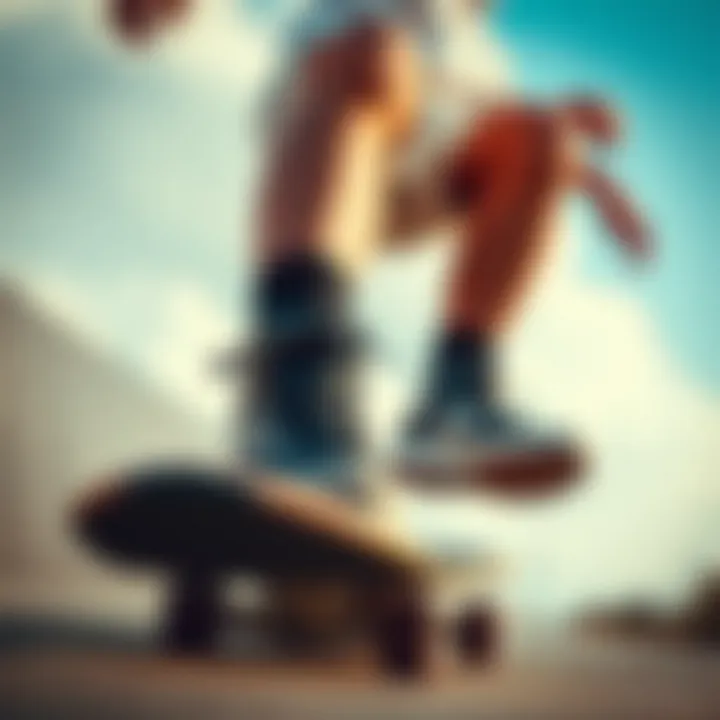
Types of Skate Shoes Available
When diving into the world of skateboarding, the choice of shoe isn’t simply a matter of style; it profoundly influences performance and safety. Different types of skate shoes cater to various skateboarding styles and personal preferences, making this a pivotal discussion within the realm of skating. Knowing the specifics can be the difference between a good session and a great one. Each shoe type offers distinctive benefits, which may address the needs of skaters, from beginners carving their first turns to seasoned pros perfecting their tricks.
Padded vs. Unpadded Shoes
Padded shoes often come with additional cushioning around the ankle and in the insole, designed to absorb impact and provide comfort during those long days at the skatepark. This extra padding is a boon for skaters who prefer extensive trick routines and need their feet well-protected. When they hit the board or land hard, the padding acts as a shock absorber, reducing foot fatigue.
On the flip side, unpadded shoes offer a more minimalistic design. This can enhance board feel, crucial for executing technical tricks. Skaters seeking to feel every nuance of their board often prefer this style, as less material between their foot and the deck can enhance sensitivity to movement. It should be noted, though, that with this benefit comes a trade-off; unpadded shoes may lead to less cushioning during high-impact landings.
"Choosing between padded and unpadded shoes can greatly alter your feel on the board, depending on your skating style and personal comfort preferences."
High-top vs. Low-top Styles
The debate between high-top and low-top styles isn't just a matter of aesthetics; it serves practical considerations too. High-top shoes envelop the ankle, providing additional support. This might be vital for skaters prone to rolling their ankles, those pushing the limits with aggressive tricks, or anyone who has had previous injuries. The added structure can enhance confidence when attempting to land big jumps.
Low-top shoes promote freedom of movement and may suit skaters looking for agility and speed. They often feel lighter and allow for a more natural range of motion. However, they offer less vertical support, which can lead to occasional missteps or injuries for some skaters. Balancing your personal comfort with your skating style is essential when deciding between these two structured designs.
Slip-on and Lace-up Variations
Slip-on shoes throw convenience into the mix, offering ease of wear while maintaining a snug fit. They can easily slide on and off, making them a favorite among skaters who like to jump directly into practice without fussing with laces. Many designs preserve solid grip and board feel, making them a clever option for short sessions or quick errands.
On the other hand, lace-up variations afford the wearer a customizable fit. You can tighten or loosen them according to comfort, which is particularly useful for those who may experience discomfort with varying foot sizes or shapes throughout the day. The practical adjustment can enhance both support and performance, tailoring the shoe’s fit to the needs of each skating session.
Recommended Brands for Skate Shoes
Selecting the right skate shoes isn't just about comfort or style—it's about choosing a brand that resonates with your skating habits and performance needs. Different brands have carved out their own niches in the skating world, offering various designs, technologies, and unique features that can make or break a skater's experience. In this section, we delve into some of the most reputable brands that deserve a closer look. Each brand brings with it a story of craftsmanship and innovation, which translates into better performance on the board and greater confidence while skating.
Understanding these brands allows skaters, whether they're just beginning or seasoned experts, to make more informed decisions based on their skateboarding style and preferences. Below, we’ll explore a few notable names in the industry, shedding light on their offerings and what they bring to the skate park.
Vans: Classic and Reliable
Vans has been a cornerstone in skate culture since its inception in 1966. Renowned for their timeless designs and durable build, the brand represents more than just footwear; it embodies a lifestyle embraced by millions. The classic Old Skool silhouette, for instance, not only offers a sleek look but also embodies exceptional grip and flexibility crucial for skate maneuvers.
- Design: Vans shoes are often characterized by their padded collars, which provide crucial support, reducing the chance of ankle injuries. This is particularly beneficial for those who practice tricks that involve a lot of footwork.
- Materials: Most Vans are constructed from suede or canvas, making them both lightweight and resistant to wear, a vital consideration for regular skaters.
Given its legacy and affiliation with iconic skateboarders, it is no surprise that Vans remains a top choice. For skaters who value timeless style and trustworthiness, these shoes have proven their worth through years of use.
Nike SB: Innovation and Style
Nike SB stands out for its commitment to pushing the envelope in skate shoe technology while blending aesthetics with functionality. Known for integrating innovative features like Zoom Air cushioning in their models, Nike SB aims to enhance the performance of skaters who demand both comfort and style.
- Performance-driven features: Shoes like the Nike SB Dunk are equipped with superior grip and impact protection. The technology behind these shoes emphasizes responsiveness, aligning perfectly with a dynamic skating style.
- Variety of styles: From collaborations with professional skateboarders to limited edition releases, Nike SB continually evolves its product line. This variety enables skaters to find a pair that not only feels good but also looks sharp.
Skaters looking for a touch of cutting-edge design paired with proven performance will find a solid ally in Nike SB.
Adidas: Performance-focused Designs
Adidas has successfully positioned itself as a powerhouse in the skate footwear market by launching cutting-edge designs specifically engineered for athletes. Their skate shoe range often blends performance with street-style aesthetics, appealing to a broad audience. The Adidas Skateboarding collection demonstrates a clear focus on the unique needs of skateboarders.
- Technologies: Adidas utilizes Boost technology in many of its models, ensuring soft cushioning that absorbs impacts during high jumps or hard landings. This technology not only enhances comfort but also allows skaters to maintain their energy longer.
- Durable materials: With the use of high-quality leather and synthetic materials, Adidas shoes offer longevity without compromising on flexibility or style.
In essence, Adidas caters to performance-oriented skaters, focusing on the long-term benefits of their investments in quality footwear.
"Choosing the right brand for skate shoes is as vital as the technique. A good shoe not only enhances performance but keeps you safe."
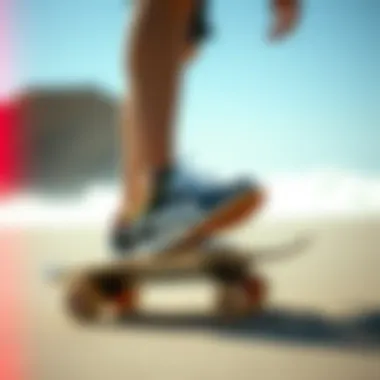
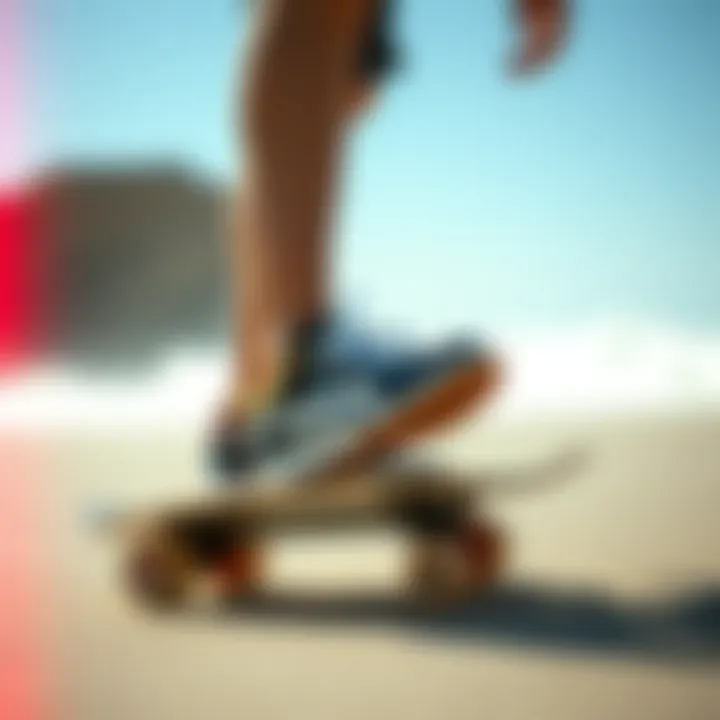
These three brands—Vans, Nike SB, and Adidas—are just a few examples of the choices available, each with unique qualities. Every skater's preference may differ, but knowing the strengths and weaknesses of each brand will help in making informed decisions that align with your specific needs on the board.
Choosing the Right Fit and Size
Choosing the right fit and size for skate shoes cannot be overstated. When it comes to skateboarding, comfort blends intricately with performance. A well-fitted shoe enhances your ability to ride smoothly, providing the necessary support during tricks or turns. Shoes that fit snugly without being overly tight will also help maximize your stability on the board, which is crucial for maintaining control and avoiding injuries.
Moreover, improper sizing can lead to discomfort and even impact your performance. Imagine trying to land a trick with shoes that rub your heels raw or pinch your toes. You’d be far more focused on that discomfort than on perfecting your moves. Ultimately, understanding your size helps in choosing a pair that feels like a second skin, aiding in achieving your skateboarding goals.
Importance of Proper Sizing
The foundation of any successful skateboarding experience starts with wearing shoes that fit correctly. Sizing can vary from brand to brand, and often it’s recommended to try on shoes before making a purchase. This is because a size that feels right in one brand might be off in another. Here are a few key aspects to consider:
- Length and Width: The ideal shoe length should allow about a thumb's width between your longest toe and the end of the shoe. As for width, skaters typically prefer a snug fit that doesn’t constrict foot movement.
- Feel of the Shoe: A properly sized shoe should feel comfortable right away. If there's significant space or constriction, it may not be the right choice.
- Sock Thickness: Consider what type of socks you’ll be wearing while skating. A thicker sock may require a different size than a thin one.
Tailoring the fit to your unique foot shape is essential for performance. Shoes that are too large may cause you to clumsily maneuver your board, while shoes that are too tight might hinder blood circulation.
Testing Comfort and Flexibility
Finding comfort in your skate shoes during the initial try-on period is nonnegotiable. To ensure that a pair will work for you, it’s crucial to test the shoes properly. Here's how to go about it:
- Walk Around: Once you've slipped on a potential new pair, take them for a spin around the store. Move your feet side to side and forward. Do they feel comfortable? You shouldn't experience any pinching or excessive movement.
- Bend and Flex: Skating requires a good amount of toe flexion. Squat or bend your feet to see how the material reacts to movement. A shoe that’s stiff isn’t likely to serve you well when it’s time to ride.
- Jump Test: If it’s possible, give a little hop in-store. This simple act can mimic the pressures placed on your shoes while skating. If they feel secure and responsive, that's a strong indication they're suited for you.
- Time Test: If you can, wear them for a longer period at home before committing. A couple of hours walking around will give you insight into how they adjust to your feet over time.
Finding the right fit and proper comfort goes beyond mere aesthetics; it’s about paving the path for enhancing your skills on the board. As you embark on your search for the perfect skate shoe, keep these details at the forefront of your mind to make an informed choice that meets your specific skating needs.
It’s not just about how they look, but how they perform under pressure. Your feet deserve the best support while you ride the concrete waves.
Evaluating Cost vs. Quality
When it comes to skate shoes, making a prudent choice means balancing cost and quality. Skateboarding, while exhilarating, places a lot of stress on your footwear. Therefore, understanding how to evaluate these two crucial factors is paramount for anyone looking to get the best out of their skating experience.
The price tag on a pair of shoes is often seen as an indicator of quality, and while that might hold some water, it’s not a straightforward equation. Higher prices don’t always translate into better performance or longevity. Just like the saying goes, "you pay for what you get", but what if you’re paying for all the bells and whistles that you don’t actually need? Understanding the balance here can save you from shelling out too much from your wallet.
Budget Considerations
Setting a budget is the first step in your search for the right skate shoes. You don't want to break the bank, but it’s crucial to consider what you’re getting for your money. A general rule of thumb is:
- Consider your skill level: Beginners might not need the most expensive model just yet. A mid-range skate shoe may serve you well as you're learning.
- Frequency of use: If you're out skating every week, consider spending a bit more on a durable pair since they’ll last longer under regular stress.
- Brand and technology: Different brands come with varying levels of technology and support. You might find that a higher-priced brand has superior grip and cushioning that can significantly enhance your skating experience.
Furthermore, explore local skate shops or online reviews to find shoes that offer the best value for your specific needs. Don’t forget to factor in the possibility of sales or discounts. A high-quality shoe may occasionally be offered at a more attractive price, which could be a win-win for your feet and your budget.
Long-term Investment in Quality
Investing in quality skate shoes can pay off in more ways than one. While the initial cost might be steep, consider the cost per use over the shoes' lifespan. A well-made shoe could last several months, while a lower-quality option might wear out in just a few weeks.
Here are some factors to ponder:
- Durability: Quality materials and construction can take the beating that skating entails.
- Performance: Higher-end shoes often come equipped with specialized features that enhance grip, support, and comfort, improving your overall performance on the board.
- Safety: A better shoe is an investment in your safety. Quality footwear is less likely to fail, which could help prevent injuries that stem from accidents caused by inadequate support or slip.
Ultimately, when evaluating cost versus quality, it's about finding a sweet spot that aligns with your skating style and needs.
Remember, making an informed decision can lead to greater satisfaction in the long run. If you skimp now, you might find yourself purchasing another pair all too soon.
In summary, while budget considerations are important, don’t overlook the long-term benefits of investing in a quality pair of skate shoes. It's wise to approach the decision with both your current needs and future potential in mind.
Maintenance and Care for Skate Shoes
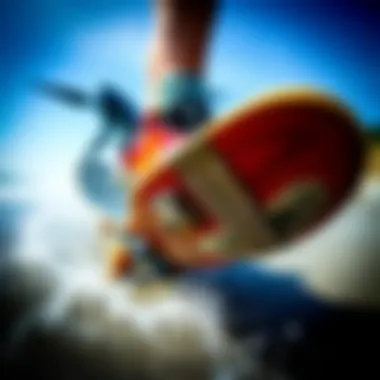
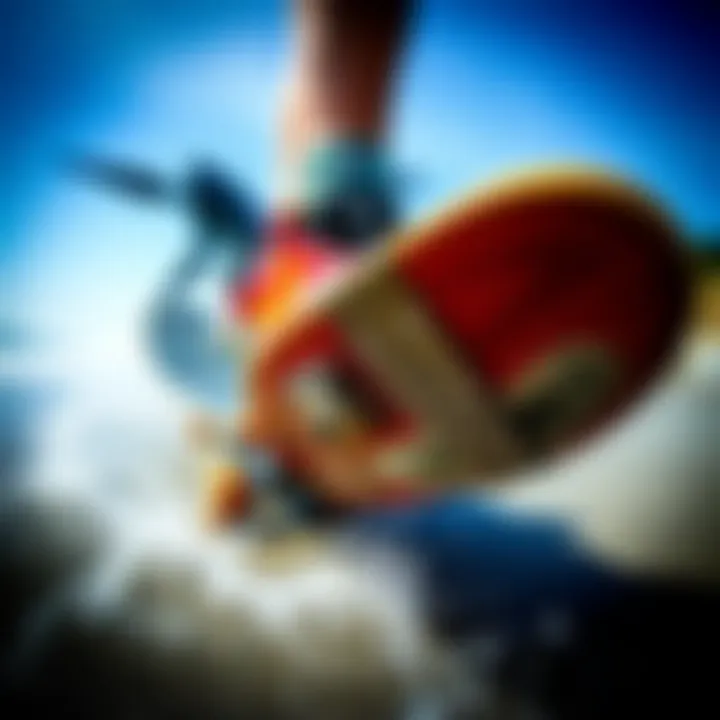
Proper maintenance and care for skate shoes are often overlooked yet essential for maximizing their lifespan and performance. Just like any high-performance sports equipment, skate shoes endure wear and tear from intense use, and neglecting them can lead to premature deterioration. Skaters want their shoes to hold up against tricks, grinds, and the brutal grip of the skateboard deck. By keeping shoes in tip-top shape, one can ensure that they provide the right level of support and comfort when needed most. Good care practices not only prolong their life but also enhance performance by maintaining their grip and cushioning.
Preventative care can rapidly become a skater's best friend. If a rider embraces the small routine of cleaning and checking their equipment regularly, they will be pleasantly surprised at how much performance improves.
Cleaning Techniques
One of the first steps in maintaining skate shoes is a proper cleaning routine. Here are some effective cleaning techniques:
- Regular Brush Off: After a skate session, a quick brush to remove dirt and debris can go a long way. A stiff-bristled brush can help remove any grit stuck in the shoe.
- Spot Cleaning: When dirt or grime finds its way into the shoe, use a damp cloth with mild soap to periodically clean specific spots. It’s crucial to avoid soaking the shoes, as moisture can weaken the materials.
- Deep Cleaning: Every once in a while, a deep clean might be necessary. Remove the insoles and laces, if possible, and wash them separately. Use a soft brush with water and a gentle detergent, making careful strokes to avoid damaging the shoe material. Rinse lightly and air dry away from direct sunlight or heat.
- Using Specialized Cleaners: Some brands offer cleaners specifically designed for skate shoes. These can be effective, but always test a small area first to check compatibility with your shoes.
"A clean shoe is not only visually appealing but also performs better. It’s the simplest way to keep them active longer."
Storage Tips for Longevity
Where and how you store your skate shoes can significantly affect their durability. Here are some tips to increase longevity through proper storage:
- Dry Storage: Always store skate shoes in a dry environment. Moisture can lead to mold or ruin the materials. Allow them to air out after each use rather than tossing them in a dark bag immediately.
- Use a Shoe Bag: If you’re traveling, consider using a breathable shoe bag to keep them protected while allowing for ventilation. Avoid plastic bags that trap moisture.
- Avoid Extreme Temperatures: Do not leave your skate shoes in places like a hot car or a damp basement. Extreme temperatures can warp the materials and compromise their integrity.
- Keep Away from Direct Sunlight: While some UV exposure is unavoidable, try to minimize direct sunlight when storing shoes to prevent fading and cracking of materials.
- Shoetrees: If a skater wants to go the extra mile, consider using shoetrees to maintain the shape of the shoe when not in use.
By implementing these maintenance and care techniques, skaters can ensure they maintain high performance and longevity from their shoes, keeping them ready for each ride. Making this an essential part of one’s routine will pay dividends in the long run, keeping skater's feet comfortable and secure.
Skate Shoes for Different Skill Levels
When it comes to skateboarding, the importance of choosing the right shoes cannot be overstated. Each skater, depending on their skill level, requires different features in their footwear to ensure optimal performance and comfort. From the eager beginners stepping onto a board for the first time to seasoned pros mastering advanced tricks, the choice of skate shoes plays a critical role in safety, confidence, and overall skating ability. Let’s delve into how the demands of each skill level inform shoe selection and why it's essential to understand these differences.
Beginner Shoes: Comfort and Support
For those just starting out, the primary focus should be on comfort and support. Beginner skateboarders often face a steep learning curve; therefore, having a shoe that offers ample cushioning can make a world of difference. It’s like trying to learn how to dance in tight shoes—uncomfortable and not very encouraging.
Key Features for Beginners:
- Soft Padding: Shoes with good padding help absorb shock, particularly for those inevitable falls. Beginners need this extra protection, as it helps to reduce the impact on their feet and joints.
- Flexible Sole: A flexible sole allows the feet to move naturally while maintaining grip. This flexibility is crucial for the learning process, making it easier to maneuver and balance on the skateboard.
- Durable Materials: While durability is important, beginners may prioritize comfort over ruggedness in the initial phase. Nonetheless, selecting shoes made from sturdy materials will prevent quick wear and tear as they practice.
Comfort won’t just help new skaters break in their skills; it will also boost their confidence. Whenever they step onto that board, they should feel secure in what they’re wearing, letting them focus on learning how to ride without worrying about foot pain.
Intermediate and Advanced Models
As skaters gain experience and begin to tackle more complex tricks and styles, their shoe requirements evolve. Intermediate and advanced skateboarders need a balance between performance and protection—akin to a tightrope walker needing both a solid grip and the freedom to leap.
Features to Look For:
- Enhanced Grip: As skaters progress, having shoes with superior grip becomes essential. Shoes equipped with sticky rubber soles can significantly improve performance on the board, providing confidence during tricks.
- Supportive Structure: With more intricate movements, the need for lateral support increases. More stable designs, such as high-tops, can provide the necessary ankle support to prevent injuries while making aggressive movements.
- Aesthetic Appeal: For many advanced skaters, style is an extension of their personality. Advanced models often come in various designs, allowing skaters to express themselves while still enjoying high functionality.
- Lightweight Construction: Advanced users often prefer shoes that won’t weigh them down. Light materials can enhance maneuverability while still offering the protection needed for high-impact skateboarding.
The End and Final Thoughts
Choosing the right skate shoes is not just about style; it has real implications for both performance and safety. Skate shoes are designed to endure the rigorous demands of skating, from grinds to jumps, and knowing which features matter can profoundly influence a skater's experience. In this article, we explored various aspects, such as grip, support, and the material durability that comes into play when selecting a pair of shoes tailored to your skating needs.
Recap of Important Considerations
When it comes down to it, several elements stand out as critical when making a choice:
- Grip and Traction: The right outsole can mean the difference between landing a trick or causing a wipe-out. Look for shoes with rubber soles that offer adequate grip on both the board and street surfaces.
- Support and Cushioning: Shoes that provide solid ankle support can prevent injuries and enhance comfort during long skate sessions. Look for models that have padding in the right places.
- Durability: Skate shoes take a beating, so materials like suede or leather that can withstand abrasions are often preferable. It's worth investing in shoes that can hold up over time.
- Fit and Comfort: Proper sizing should never be overlooked. Shoes should fit snugly without being constricting, ensuring the skater can maintain control and precision in every move.
- Skill-appropriate Design: As your skills progress, your shoe needs do too. Whether you're just starting or hitting advanced tricks, your footwear should align with your level.
Encouragement to Choose Wisely
Ultimately, the right pair of skate shoes can significantly elevate your skating experience. It's about more than aesthetics; it's about functionality and safety. Don’t rush the decision; consider your individual needs and style of skating before making a purchase. Think about how long you skate, the types of tricks you want to master, and the environments you typically ride in. Skaters of all levels can benefit by giving this decision the attention it deserves.
With so many options available, taking the time to choose wisely ensures that you'll not only perform better but also feel more confident on your board. After all, skilled skaters understand that their gear is not merely an accessory but an integral part of their craft. As you tread the path of choosing, remember that often the difference is in the details.
"The shoe that fits one person pinches another; there is no recipe for living that suits all cases." — Carl Jung
Now, equipped with insights from this guide, you’re ready to step into the skate world with confidence. Happy skating!



